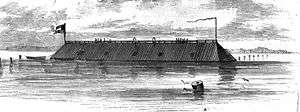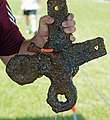CSS Georgia (ironclad)
CSS Georgia, also known as State of Georgia and Ladies' Ram, was an ironclad warship built in Savannah, Georgia in 1862 during the American Civil War.[2] The Ladies' Gunboat Association raised $115,000 for her construction to defend the port city of Savannah.[3]
 | |
| History | |
|---|---|
| Name: | Georgia |
| Laid down: | 1862 |
| Launched: | 1863 |
| Commissioned: | 1863 |
| Decommissioned: | December 21, 1864 |
| Fate: | Scuttled to prevent capture. Currently undergoing salvage. |
| General characteristics | |
| Length: | 250 ft (76 m) |
| Beam: | 60 ft (18 m) |
| Complement: | 200 officers and men |
| Armament: | 4 to 9 heavy cannons |
CSS GEORGIA (ironclad) | |
 | |
| Nearest city | Savannah, Georgia |
| Area | 1.6 acres (0.65 ha) |
| Built | 1862 |
| NRHP reference No. | 86003746[1] |
| Added to NRHP | February 10, 1987 |
Service history
Commanded by Lieutenant Washington Gwathmey, CSN, the new warship was employed to defend the river channels below Savannah, using her cannons to prevent a Union advance on the city from the sea.[3] When her steam engines turned out to lack sufficient power for offensive use, Georgia was anchored in the Savannah River as a floating battery, protecting both the city and Fort Jackson.[2] Georgia had been in service about 20 months, when Sherman's March to the Sea captured Savannah by land on December 21, 1864. Her Confederate crew scuttled the ship to prevent her capture and use against the South.
Wreck
In 1866 the ship's railroad iron armor was partially salvaged and the wooden hull was shattered by the underwater charges used to remove it. The wreck was then left alone and forgotten. In 1968 Georgia was rediscovered during a dredging operation of the Savannah River.[2] The wreck was left untouched, although accidental impacts from dredging equipment and the anchors marking the site location may have damaged what remained.[2] By 1992, all that was survived were portions of her forward and aft casemates and parts of her engines, including the boilers, shafts, propellers, and condensers.[3] Several of her cannon were located nearby, along with assorted ordnance.[3]
In May 2012 the United States Army Corps of Engineers (USACE) budgeted $14 million to raise the remains of the ironclad to allow for further dredging.[4] Archeologists working for the USACE Savannah District, assisted by teams from the United States Navy, raised a 64 square feet (5.9 m2) section of Georgia on November 12, 2013.[5]
Further relics are being recovered during an ongoing nine-month salvage operation in 2015, as an initiative to upgrade waterway access for deep sea vessels requires its dredging to 47 feet (14 m). As of April 2015, USACE, with archaeologists from Texas A&M University, had recovered over 1000 artifacts.[6] The removal of ordnance and the lifting of the major remains of the casemates and machinery occurred in June–August 2015.[7][8]
In the 1980s a photograph was discovered that allegedly shows the Georgia,[9] but it was later discovered to be fake.
Georgia was placed on the National Register of Historic Places in 1987 (#86003746).
Artifacts recovered in 2015
 A brass artifact - part of a wood and rope assembly to move a cannon
A brass artifact - part of a wood and rope assembly to move a cannon Iron artifact (heavily corroded)
Iron artifact (heavily corroded) A brass cannon elevation screw (still turns)
A brass cannon elevation screw (still turns) An unrestored iron artifact (heavily corroded)
An unrestored iron artifact (heavily corroded) A resin cast model of an iron artifact
A resin cast model of an iron artifact A cannonball and holder for a grapeshot
A cannonball and holder for a grapeshot
See also
- Fort James Jackson, CSS Georgia sank in the river next to Fort James Jackson
References
- "National Register Information System". National Register of Historic Places. National Park Service. November 2, 2013.
- Watts, Gordon P; James Jr, Stephen R. (February 2007). "In Situ Archaeological Evaluation of the CSS Georgia Savannah Harbor, Georgia" (PDF). Final Grant Report to the U.S. Army Corps of Engineers. Archived from the original (PDF) on February 8, 2012. Retrieved May 7, 2012.
- Anuskiewicz, Richard J; Garrison, Ervan G. (1992). "Underwater archaeology by braille: Survey methodology and site characterization modeling in a blackwater environment - A study of a scuttled confederate ironclad, CSS Georgia". In: Cahoon, LB. (ed.) Proceedings of the American Academy of Underwater Sciences Twelfth Annual Scientific Diving Symposium "Diving for Science 1992". Held September 24–27, 1992 at the University of North Carolina at Wilmington, Wilmington, NC. American Academy of Underwater Sciences. Archived from the original on September 5, 2012. Retrieved January 11, 2011.
- Russ Bynum (May 5, 2012). "Civil War shipwreck in the way of Ga. port project". Associated Press. Retrieved May 7, 2012.
- Rodriguez, Raquel (November 13, 2013). "A Piece Of Civil War History Raised From The Savannah River". WSAV-TV. Retrieved November 15, 2013.
- "New artifacts reveal more about Civil War life". Balancing the Basin. USACE, Savannah District. April 30, 2015. Retrieved May 17, 2015.
- Brown, Heather (May 15, 2015). "MDSU-2 Prepares for Historic Dive". America's Navy. US Navy. Retrieved May 17, 2015.
- Gast, Phil; Gannon, Matthew (August 21, 2015). "'Seeing eye dogs' help Navy divers recover Civil War vessel in murky river". CNN. Retrieved August 23, 2015.
- article
Bibliography
- Bisbee, Saxon T. (2018). Engines of Rebellion: Confederate Ironclads and Steam Engineering in the American Civil War. Tuscaloosa, Alabama: University of Alabama Press. ISBN 978-0-81731-986-1.
External links
- USACE Savannah CSS Georgia project website
- 2015 Raise the Wreck Festival

This article incorporates text from the public domain Dictionary of American Naval Fighting Ships.